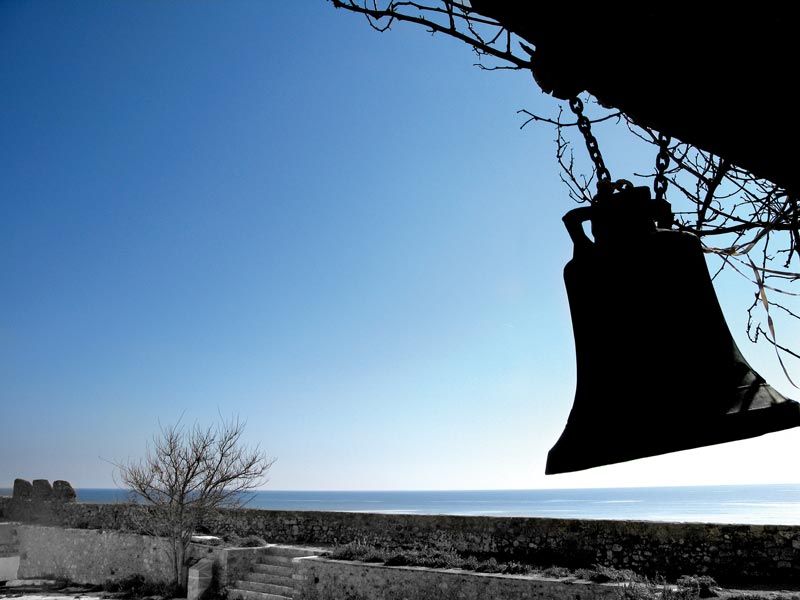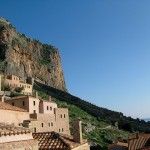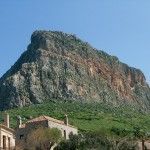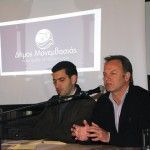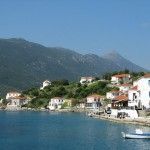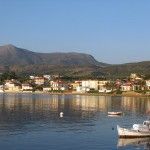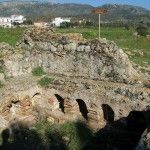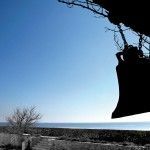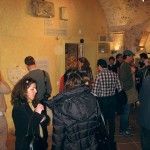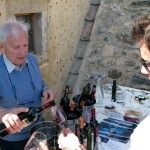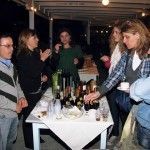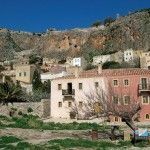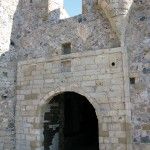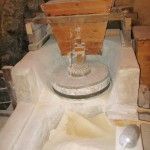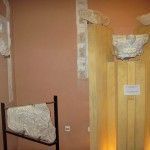Monemvasia: More Than A Weekend Destination
“Our aim is for Monemvasia to become a multi-day holiday destination and not just a weekend getaway destination,” the president of the Monemvasia Tourism Promotion Committee, Babis Lyras, told Greek travel journalists recently.
Monemvasia, located in Laconia, southeastern Peloponnese, was established as a municipality in 2011 under the Kallikratis program by the unification of the former municipalities of Zarakas, Molai, Asopou, Monemvasia and Vion.Prior to the journalists’ tour, the Monemvasia Municipality held a press conference and gave insight on the destination’s plans to attract foreign tourists.

View of the rock on which the castle and the town of Monemvasia are built. The town’s name derives from two Greek words, “mone” and “emvasia,” meaning “single entrance.”
The municipality announced its targeted tourism development strategy that aims to include Monemvasia within the international market and attract foreign visitors, as, due to the crisis, domestic tourism last year had dropped some 60 percent.
Greek visitors make up 90 percent of Monemvasia’s total visitation demand.
According to Monemvasia Mayor Iraklis Trihilis, the region’s tourism development is top priority and the municipality is currently at the start of an effort hoped to soon deliver concrete and measurable results for the destination.
“The promotion of the tourism product has been done in accordance to a specific design based on modern methods of tourism marketing,” the mayor said.
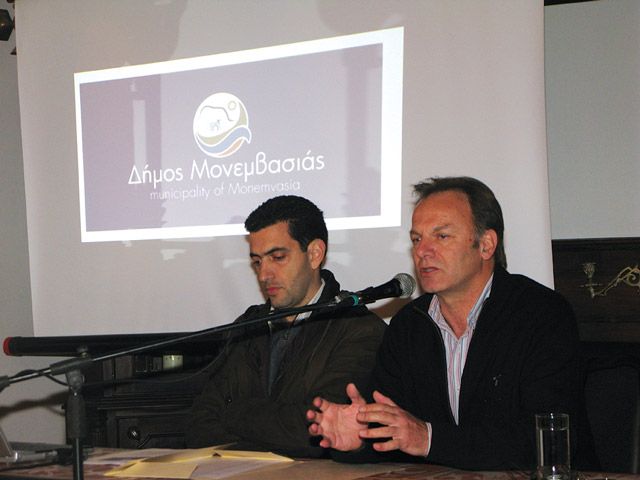
The importance of the road network that leads to Monemvasia was highlighted at the press conference given to Greek journalists by the president of the Monemvasia Tourism Promotion Committee, Babis Lyras, and Monemvasia Mayor Iraklis Trihilis. The already improved road network, which will be further enhanced through E.U. funds, is currently the only access to the area.
During the press conference, the variation of Monemvasia’s tourism portfolio was presented. The portfolio included an array of monuments, landmarks and travel experiences aimed to make the area a key selection for multi-day holidays for both Greek and foreign visitors.
The municipality’s strategy, however, will evolve around Monemvasia’s top attraction, the Castle, in combination with the local gastronomy and tours to other attractions scattered throughout the area.
The municipality informed that efforts are in process so the Monemvasia Castle would be established as a global landmark, a “must see destination.”
According to the tourism promotion committee, the Castle could play a major role in transforming the destination into a multi-day holiday destination. “The Monemvasia Castle is the area’s dominant tourism brand with destinations, attractions, activities and travel experiences throughout the region,” Mr. Lyras said.
The tourism portfolio of Monemvasia also includes excursions to the sunken city of Plytra (Ancient Asopos), the traditional watermill in Talanta, the Kastanias Cave, the lighthouse at Cape Malea and the Petrified Forest that dates back four million years.

Ancient Asopos, Plytra. The ancient town of Asopos has been identified as the ruins on the small promontory southeast of the seaside settlement of Plytra. According to inscriptions and excavations, the ancient town dates back to the late Hellenistic period (323 -146 BC). Ruins are still visible on the shore and on the seabed, as much of the ancient city is submerged. On the coast are tombs (photo) and at least two bath houses, one of which has mosaic floors and the ruins of other buildings and reservoirs.
Among the committee’s plans is to extend the tourism season of Monemvasia. “Given the circumstances, this could be achieved by promoting the destination to foreign markets and through the parallel development of alternative forms of tourism that are available during low season,” he said.
The alternative forms of tourism to be focused on include hiking, mountain climbing, cultural and religious tourism.
In regards to the latter, the castle alone contains 40 churches, of which today several are in very good condition.
(Τhe committee was happy to inform that the Byzantine icon of Christ Elkomenos—Christ in Chains in Greek—that was stolen 32 years ago was returned to the Church of Elkomenos in the Monemvasia Castle. This icon is said to be one of the finest creations of the Palaeologan Renaissance and considered a priceless church heirloom.)
In regards to mountain climbing, the mayor said that Monemvasia had nothing to envy from Thailand or Kalymnos, as the area of Parnonas has unlimited potential to develop climbing spots due to the composition and the morphology of the surrounding rocks.
In Agios Nikolaos Vion, two mountain climbing fields have already been created with more than 100 routes. Also, in the area of Kyparisiou, Greek and French climbers have opened routes.
Among the comparative advantages of Monemvasia is also the romantic atmosphere of the castle along with the many small temples in unique locations. “This can make Monemvasia a first choice destination for religious and civil marriages and other similar events,” the mayor said.

Gerakas Port, set in a winding fjord that terminates in a wetland, is a popular anchorage for sailors who relax at its dockside fish tavernas and cafes. Until the summer of 2003, Gerakas had a connection to Pireaus by Flying Dolphin. Today, the only way to access the area is by car.
The committee also made reference to the proximity of Monemvasia to well-known tourism destinations such as Elafonisos, Mystras, Mani, Kythera and the caves of Diros. “This is another competitive advantage since all destinations can be accessed via a short journey that would begin from the Monemvasia municipality,” Mr. Lyras said.
Among the municipality’s intentions is also the establishment of a quality standard for the region’s cuisine and hospitality services that aim to raise the level of service and support the connection of local agricultural products with tourism.
It was emphasized that the new tourism strategy of Monemvasia is not directed to mass tourism since the destination’s infrastructure is not suitable for its support.
The strategy is addressed to the visitor that is willing to see “something more,” tour places that have not been promoted so far and are essentially “hidden treasures” of the region.
The fam trip to Monemvasia was organized by the municipality’s tourism promotion committee with the assistance of Greek tourism journalist Margarita Manousou.
- The Monemvasia Castle is the most important tourism attraction of the municipality and the benchmark for the entire region’s tourism product. It is an internationally recognized destination and an essential stop when traveling the Peloponnese. It has officially been declared an as archaeological site, a place of great natural beauty, traditional village and monument of European Cultural Heritage. In recent years, the municipality has made efforts for the integration of Monemvasia in the World Heritage of UNESCO.
- View of the rock on which the castle and the town of Monemvasia are built. The town's name derives from two Greek words, "mone" and "emvasia," meaning "single entrance."
- The importance of the road network that leads to Monemvasia was highlighted at the press conference given to Greek journalists by the president of the Monemvasia Tourism Promotion Committee, Babis Lyras, and Monemvasia Mayor Iraklis Trihilis. The already improved road network, which will be further enhanced through E.U. funds, is currently the only access to the area.
- Gerakas Port, set in a winding fjord that terminates in a wetland, is a popular anchorage for sailors who relax at its dockside fish tavernas and cafes. Until the summer of 2003, Gerakas had a connection to Pireaus by Flying Dolphin. Today, the only way to access the area is by car.
- The Elia seaside settlement. Its history goes back to Mycenaean times when it was the site of ancient Viandini. Today Elia is a summer resort with hotels, rooms to rent, cafe-bars and restaurants.
- Ancient Asopos, Plytra. The ancient town of Asopos has been identified as the ruins on the small promontory southeast of the seaside settlement of Plytra. According to inscriptions and excavations, the ancient town dates back to the late Hellenistic period (323 -146 BC). Ruins are still visible on the shore and on the seabed, as much of the ancient city is submerged. On the coast are tombs (photo) and at least two bath houses, one of which has mosaic floors and the ruins of other buildings and reservoirs.
- Wine tasting event
Wine tasting event
- Presentation of local products
Presentation of local products
- The entrance of the castle
The entrance of the castle
- Visit to a traditional watermill
Visit to a traditional watermill

